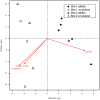Changes of soil bacterial diversity as a consequence of agricultural land use in a semi-arid ecosystem
- PMID: 23527207
- PMCID: PMC3603937
- DOI: 10.1371/journal.pone.0059497
Changes of soil bacterial diversity as a consequence of agricultural land use in a semi-arid ecosystem
Abstract
Natural scrublands in semi-arid deserts are increasingly being converted into fields. This results in losses of characteristic flora and fauna, and may also affect microbial diversity. In the present study, the long-term effect (50 years) of such a transition on soil bacterial communities was explored at two sites typical of semi-arid deserts. Comparisons were made between soil samples from alfalfa fields and the adjacent scrublands by two complementary methods based on 16S rRNA gene fragments amplified from total community DNA. Denaturing gradient gel electrophoresis (DGGE) analyses revealed significant effects of the transition on community composition of Bacteria, Actinobacteria, Alpha- and Betaproteobacteria at both sites. PhyloChip hybridization analysis uncovered that the transition negatively affected taxa such as Acidobacteria, Chloroflexi, Acidimicrobiales, Rubrobacterales, Deltaproteobacteria and Clostridia, while Alpha-, Beta- and Gammaproteobacteria, Bacteroidetes and Actinobacteria increased in abundance. Redundancy analysis suggested that the community composition of phyla responding to agricultural use (except for Spirochaetes) correlated with soil parameters that were significantly different between the agricultural and scrubland soil. The arable soils were lower in organic matter and phosphate concentration, and higher in salinity. The variation in the bacterial community composition was higher in soils from scrubland than from agriculture, as revealed by DGGE and PhyloChip analyses, suggesting reduced beta diversity due to agricultural practices. The long-term use for agriculture resulted in profound changes in the bacterial community and physicochemical characteristics of former scrublands, which may irreversibly affect the natural soil ecosystem.
Conflict of interest statement
Figures


References
-
- Saygin SD, Basaran M, Ozcan AU, Dolarslan M, Timur OB, et al. (2011) Land degradation assessment by geo-spatially modeling different soil erodibility equations in a semi-arid catchment. Environ Monit Assess 180: 201–215. - PubMed
-
- Zhao WZ, Xiao HL, Liu ZM, Li J (2005) Soil degradation and restoration as affected by land use change in the semiarid Bashang area, northern China. Catena 59: 173–186.
-
- Mahamane L, Mahamane S (2005) Biodiversity of ligneous species in semi-arid to arid zones of southwestern Niger according to anthropogenic and natural factors. Agr Ecosyst Environ 105: 267–271.
-
- Underwood EC, Viers JH, Klausmeyer KR, Cox RL, Shaw MR (2009) Threats and biodiversity in the mediterranean biome. Divers Distrib 15: 188–197.
Publication types
MeSH terms
Substances
LinkOut - more resources
Full Text Sources
Other Literature Sources

